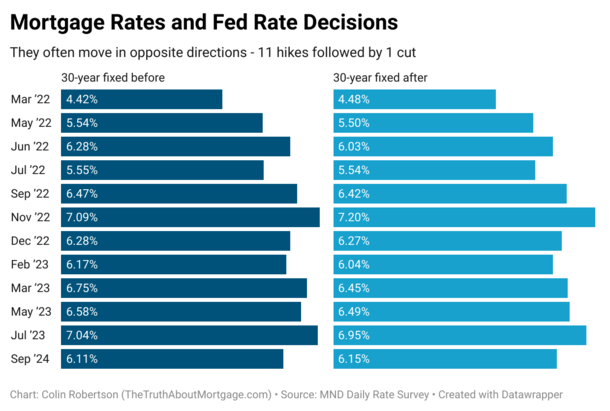Anybody who works within the trade in all probability noticed this coming. However those that don’t is perhaps left scratching their head.
Yesterday, the Fed lastly pivoted and minimize its personal fed funds price, but mortgage charges went up. Why does this all the time appear to occur?
Shouldn’t excellent news on the rate of interest entrance push charges decrease throughout the board? Appears completely logical till you dig into the main points.
There are two foremost the reason why mortgage charges usually defy the Fed’s personal transfer.
One is that the Fed’s coverage is usually pretty telegraphed and never a shock, and the opposite is that the information is often baked in already.
The Fed Merely Follows the Financial Knowledge

First issues first, the Federal Reserve is just making financial coverage selections (hike, minimize, nothing) based mostly on the financial information in entrance of them.
So their FOMC assertion and accompanying rate of interest choice usually don’t come as a lot of a shock.
Yesterday, there was a bit of extra uncertainty than regular, with each a 25-basis level and 50-basis level minimize a chance.
The Fed opted to go along with a 50-bps minimize, which had been the favourite with a ~60%+ chance per CME FedWatch.
In different phrases, the Fed did what the market anticipated, as they usually do. The rationale the Fed does what the market expects is as a result of they base their selections on publicly accessible information.
And the information is considerably previous by the point the Fed makes its announcement. That removes a lot of the aspect of shock.
Nevertheless, what can transfer the bond market after the FOMC rate of interest choice is the press convention with the Federal Reserve chairman Jerome Powell.
He defined that they took the step of constructing a 50-bps minimize as a result of that they had patiently waited for inflation to come back down, and have been now comfy to make a “robust transfer.”
The larger minimize permits them to (hopefully) keep away from an enormous enhance in unemployment whereas additionally stopping a return to excessive inflation.
However he added that there shouldn’t be an expectation that 50-bps cuts are the brand new regular. The choices will nonetheless be made meeting-by-meeting.
So no actual surprises right here and never sufficient new info for mortgage charges to proceed falling.
Mortgage Lenders Have Already Dropped Charges a Ton Main As much as the Fed Charge Resolution
The opposite related piece right here is that mortgage lenders have been already aggressively decreasing mortgage charges heading into the Fed assembly.
If you happen to take a look at the 30-year fastened, it had already fallen almost 150 foundation factors (1.50%) because the finish of April.
In different phrases, bonds and mortgage-backed securities (MBS) have been making massive strikes based mostly on the information and the anticipated Fed pivot for months now.
Loads of the value enchancment, if not almost all, was priced in earlier than Fed day. It’s form of a “promote the information” state of affairs.
You realize one thing is coming so you purchase bonds or MBS and as soon as the information really hits, it may very well be time to unload a bit.
On this case, it’s simply an anticipated bounce in the wrong way as everybody digests the widely-anticipated Fed choice.
To place it one other approach, mortgage lenders have a tendency to cost their charges defensively forward of an FOMC rate of interest choice, so usually occasions there’s a little bit of a reduction rally after a hike.
Simply have in mind that is however in the future, and mortgage charges might develop a longer-term trajectory based mostly on what’s occurring with the Fed and underlying financial information.
However the greatest approach to observe mortgage charges is by watching the 10-year bond yield and/or MBS costs.
Since yesterday, the 10-year yield has already ticked up about 10 foundation factors and MBS costs have fallen a bit.
No main motion, however maybe a disappointment for many who thought mortgage charges would fall additional after the Fed minimize charges.
Mortgage Charges Are likely to Defy the Fed
September 18th, 2024: Charge minimize, mortgage charges up
July twenty sixth, 2023: Charge hike, mortgage charges down
Could third, 2023: Charge hike, mortgage charges down
March twenty second, 2023: Charge hike, mortgage charges down
February 1st, 2023: Charge hike, mortgage charges down
December 14th, 2022: Charge hike, mortgage charges down
November 2nd, 2022: Charge hike, mortgage charges UP
September twenty first, 2022: Charge hike, mortgage charges down
July twenty seventh, 2022: Charge hike, mortgage charges down
June fifteenth, 2022: Charge hike, mortgage charges down
Could 4th, 2022: Charge hike, mortgage charges down
March sixteenth, 2022: Charge hike, mortgage charges UP
I used to be curious what tends to occur with mortgage charges on Fed choice day so I regarded on the previous 12 selections and used MND information for mortgage price motion on the times in query.
I included the 11 price hikes since March 2022 and the pivot to a minimize yesterday. Unsurprisingly, so far as I’m involved, mortgage charges are inclined to defy the Fed most of the time.
In different phrases, when the Fed raises charges, mortgage charges usually fall. And when the Fed cuts, mortgage charges have a tendency go up.
I’ll want extra information on the latter piece as they proceed to make anticipated cuts. But it surely wouldn’t shock me to see this pattern proceed.
Simply word that the mortgage price motion post-Fed price choice usually isn’t vital. And over time, issues can change much more.
For instance, though lenders usually minimize charges on Fed hike day, the longer-term route of mortgage charges was decidedly greater.
Now we would see the alternative. Because the Fed is anticipated to make extra cuts, lenders might step by step decrease charges over time.
However once more, it’s not due to the Fed! It’s the underlying information and route of the economic system.
